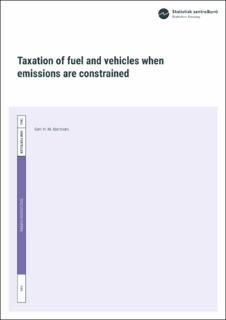Taxation of fuel and vehicles when emissions are constrained
| dc.contributor.author | Bjertnæs, Geir Haakon | |
| dc.date.accessioned | 2021-04-07T08:57:28Z | |
| dc.date.available | 2021-04-07T08:57:28Z | |
| dc.date.issued | 2021-03 | |
| dc.identifier.issn | 1892-753X | |
| dc.identifier.uri | https://hdl.handle.net/11250/2736533 | |
| dc.description.abstract | A tax on fuel combined with tax exemptions or subsidies for fuel-efficient vehicles is implemented in many countries to fulfill the Paris agreement and to curb mileage-related externalities from road traffic. The present study shows that a tax on fuel should be combined with heavier taxation of low- and zero emission vehicles to curb mileage-related externalities and to fulfill emission targets within the transport sector. The emission target is fulfilled by adjusting the CO2-tax component on fuel. The road user charge on fuel is designed to curb mileage-related externalities. The heavier tax on low- and zero emission vehicles prevent motorists from avoiding the road user charge on fuel by purchasing low- and zero emission vehicles. | en_US |
| dc.language.iso | eng | en_US |
| dc.publisher | Statistisk sentralbyrå | en_US |
| dc.relation.ispartofseries | Discussion Paper;No. 949 | |
| dc.rights | Navngivelse 4.0 Internasjonal | * |
| dc.rights.uri | http://creativecommons.org/licenses/by/4.0/deed.no | * |
| dc.subject | Transportation | en_US |
| dc.subject | Optimal taxation | en_US |
| dc.subject | Environmental taxation | en_US |
| dc.subject | Global warming | en_US |
| dc.title | Taxation of fuel and vehicles when emissions are constrained | en_US |
| dc.type | Working paper | en_US |
| dc.source.pagenumber | 25 | en_US |
Tilhørende fil(er)
Denne innførselen finnes i følgende samling(er)
-
Discussion Papers [1002]

